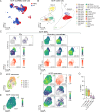Peritoneal resident macrophages constitute an immunosuppressive environment in peritoneal metastasized colorectal cancer
- PMID: 40246872
- PMCID: PMC12006467
- DOI: 10.1038/s41467-025-58999-6
Peritoneal resident macrophages constitute an immunosuppressive environment in peritoneal metastasized colorectal cancer
Abstract
Patients with peritoneal metastasized colorectal cancer (PM-CRC) have a dismal prognosis. We hypothesized that an immunosuppressive environment in the peritoneal cavity underlies poor prognosis. We define the composition of the human peritoneal immune system (PerIS) using single-cell technologies in 18 patients with- and without PM-CRC, as well as in matched peritoneal metastases (n = 8). Here we show that the PerIS contains abundant immunosuppressive C1Q+VSIG4+ and SPP1+VSIG4+ peritoneal-resident macrophages (PRMs), as well as monocyte-like cavity macrophages (mono-CMs), which share features with tumor-associated macrophages, even in homeostasis. In PM-CRC, expression of immunosuppressive cytokines IL10 and VEGF increases, while simultaneously expression of antigen-presenting molecules decreases in PRMs. These intratumoral suppressive PRMs originate from the PerIS, and intraperitoneal depletion of PRMs in vivo using anti-CSF1R combined with anti-PD1 significantly reduces tumor burden and improves survival. Thus, PRMs define a metastatic site-specific immunosuppressive niche, and targeting PRMs is a promising treatment strategy for PM-CRC.
© 2025. The Author(s).
Conflict of interest statement
Competing interests: A.L.Y. received consultancy fees from Janssen, Johnson & Johnson, DeciBio, and was previously employed by GSK. None of the aforementioned entities had relation to the content of this publication. L.V. received consultancy fees from Bayer, MSD, Genentech, Servier, and Pierre Fabre, but these had no relation to the content of this publication. L.V. is an employee of Genentech Inc. J.G. has a collaboration with Roche. The other authors declare no competing interests.
Figures






Similar articles
-
T-cell responses in colorectal peritoneal metastases are recapitulated in a humanized immune system mouse model.Front Immunol. 2024 Jul 9;15:1415457. doi: 10.3389/fimmu.2024.1415457. eCollection 2024. Front Immunol. 2024. PMID: 39044825 Free PMC article.
-
The immunomodulatory role of paracrine signalling factor VSIG4 in peritoneal metastases.Sci Rep. 2024 Jul 30;14(1):17522. doi: 10.1038/s41598-024-64449-y. Sci Rep. 2024. PMID: 39080370 Free PMC article.
-
5-aza-2'-deoxycytidine potentiates anti-tumor immunity in colorectal peritoneal metastasis by modulating ABC A9-mediated cholesterol accumulation in macrophages.Theranostics. 2022 Jan 1;12(2):875-890. doi: 10.7150/thno.66420. eCollection 2022. Theranostics. 2022. PMID: 34976218 Free PMC article.
-
Targeting the Tumor Microenvironment in Colorectal Peritoneal Metastases.Trends Cancer. 2020 Mar;6(3):236-246. doi: 10.1016/j.trecan.2019.12.008. Epub 2020 Jan 16. Trends Cancer. 2020. PMID: 32101726 Review.
-
The Macrophages-Microbiota Interplay in Colorectal Cancer (CRC)-Related Inflammation: Prognostic and Therapeutic Significance.Int J Mol Sci. 2020 Sep 18;21(18):6866. doi: 10.3390/ijms21186866. Int J Mol Sci. 2020. PMID: 32962159 Free PMC article. Review.
Cited by
-
The Immune Microenvironment: New Therapeutic Implications in Organ Fibrosis.Adv Sci (Weinh). 2025 Aug;12(30):e05067. doi: 10.1002/advs.202505067. Epub 2025 May 20. Adv Sci (Weinh). 2025. PMID: 40391706 Free PMC article. Review.
-
Aging murine peritoneal macrophages undergo female-specific remodeling driven by hormone-dependent and independent mechanisms.bioRxiv [Preprint]. 2025 Jun 27:2025.06.11.659200. doi: 10.1101/2025.06.11.659200. bioRxiv. 2025. PMID: 40666991 Free PMC article. Preprint.
References
-
- Franko, J. et al. Prognosis of patients with peritoneal metastatic colorectal cancer given systemic therapy: an analysis of individual patient data from prospective randomised trials from the Analysis and Research in Cancers of the Digestive System (ARCAD) database. Lancet Oncol.17, 1709–1719 (2016). - PubMed
-
- Bijelic, L., Yan, T. D. & Sugarbaker, P. H. Failure analysis of recurrent disease following complete cytoreduction and perioperative intraperitoneal chemotherapy in patients with peritoneal carcinomatosis from colorectal cancer. Ann. Surg. Oncol.14, 2281–2288 (2007). - PubMed
-
- Cho, B. C. et al. Tiragolumab plus atezolizumab versus placebo plus atezolizumab as a first-line treatment for PD-L1-selected non-small-cell lung cancer (CITYSCAPE): primary and follow-up analyses of a randomised, double-blind, phase 2 study. Lancet Oncol.23, 781–792 (2022). - PubMed
MeSH terms
LinkOut - more resources
Full Text Sources
Medical
Research Materials
Miscellaneous

